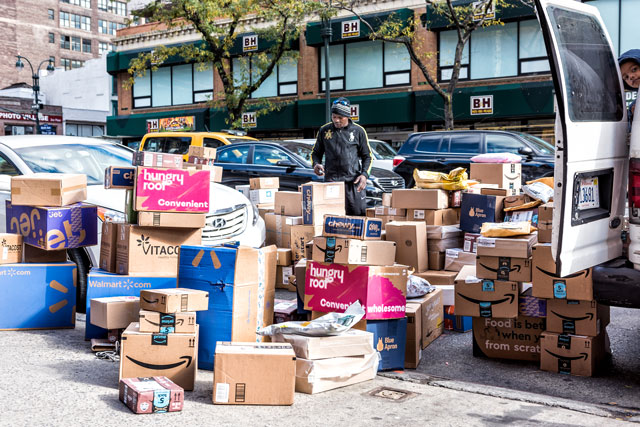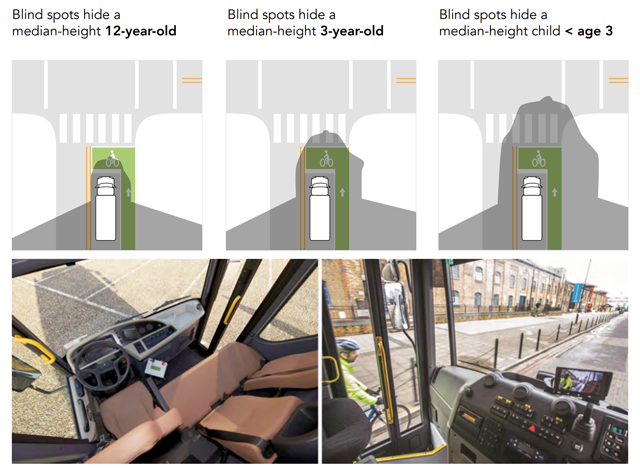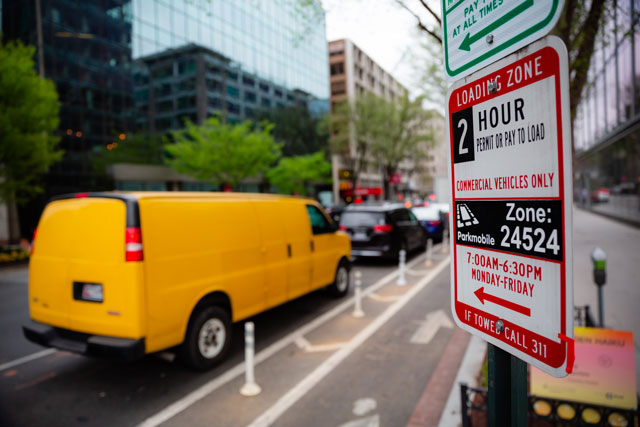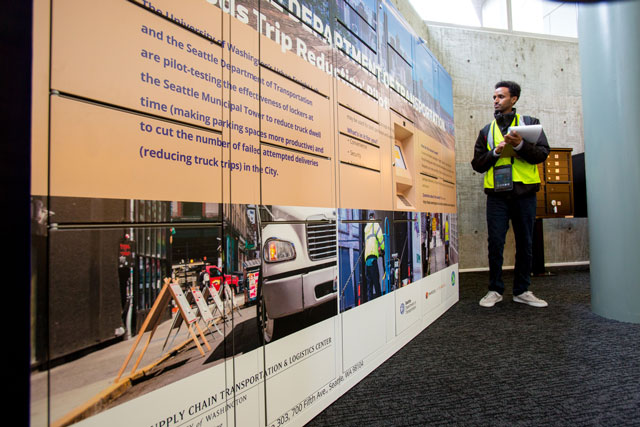
This is part one of our series on urban freight and achieving a “triple zero” bottom-line: zero emissions, zero road deaths and zero exclusion from core services and opportunities.
A line of trucks files patiently into the Port of Shenzhen. A delivery driver straps groceries to the back of their motorcycle in Kampala. A truck stops to unload in a bicycle lane in downtown Seattle.
A package arrives right on time.
Cities depend on the reliable delivery of goods every day. Without deliveries, hospitals exhaust critical supplies in 24 hours and grocery stores run out of produce in 72 hours. Since COVID-19 shutdowns, people are getting more goods delivered to their door than ever before, from cat food to sofas to takeout. But this is also a long-term trend. Demand for goods is expected to more than triple by 2050, and how cities deal with increasing freight traffic has broad implications.
Globally, freight accounts for 40% of transport-related greenhouse gas emissions and is a significant factor in deadly air pollution. Exposure to air pollution disproportionately affects poor communities and marginalized communities of color, which are also far more likely to be near polluting truckyards, warehouses and shipping ports.
On urban streets, the consequences of not designing for freight can be devastating for vulnerable road users too. Despite making up less than 10% of the vehicle population in most countries, freight vehicles are responsible for a quarter of road fatalities in the European Union. In the U.S. they are 50% more likely to kill pedestrians than passenger cars. And in Bogotá, a city investing heavily in its Vision Zero and bicycle safety plan to eliminate road deaths, a quarter of bicyclist deaths last year were due to trucks.
In July 2020, WRI hosted a four-part webinar series that gathered nearly 600 experts from universities, government and companies from across the world to discuss a “triple zero” vision for cities: zero emissions, zero road deaths and zero exclusion from core services and opportunities. The consensus was clear: cities must radically transform how they do freight if they are to create greener, safer and more inclusive places to live.
It starts with how we design and plan our streets and public spaces.
Your Friendly Neighborhood Warehouse
Chapelle International sits atop a formerly abandoned railyard just north of Paris’s city center. Just outside is a two-acre urban farm, growing 45 tons of produce annually for a nearby farm-to-table restaurant. The airy, multi-level building hosts a data center, chic office spaces and a tennis court.
The facility has also shipped over a half million parcels since its opening in 2018.
Chapelle International is just one of about 25 warehouses recently constructed within Paris proper to sate the country’s $734 billion appetite for online shopping and home deliveries. The move into Paris’s dense urban center signals the potential reversal of a 40-year trend that has sent distribution centers sprawling deeper into the suburbs in search of cheap land and ready highway on-ramps. Logistics sprawl created millions of tons of added emissions and plopped vast, polluting grayfields in the backyards of marginalized communities.
“Logistics hotels,” as warehouses like Chapelle International are called, herald a new way of doing freight, says Laetitia Dablanc, a researcher on logistics at Université Gustave Eiffel in Paris. Major shipping companies like Amazon are reclaiming formerly abandoned spaces like railyards, parking garages and even shopping malls to nudge distribution centers closer to consumers’ doorsteps.
Logistics hotels optimize what carriers call the “last mile” of the delivery chain. The final leg of urban deliveries accounts for more than half of carriers’ total delivery costs and is rife with inefficiencies. In the United Kingdom, trucks spend roughly a third of their trips driving around empty, while U.S. trucks collectively drive 20 billion empty, or “deadhead,” miles every year.
Pooling loads and filling trucks more efficiently at last-mile logistics centers means fewer trucks and less deadheading. Urban consolidation creates big cost savings for carriers and can potentially slash freight emissions by 20 to 50%.
Logistics hotels can also serve as starting points for new types of delivery vehicles, like electric bicycles. Cargo e-bikes are taking off in Europe and New York, which recently permitted 100 cargo e-bikes to use commercial loading zones. Some studies claim emission-free cargo e-bikes could potentially replace more than half of motorized freight trips in dense European cities.
Design for Freight, But Not Only for Freight
“There is an inherent conflict between how we design streets for large freight vehicles and vulnerable road users,” explains Alison Conway, professor at The City College of New York. Trucks need wide turning clearances and ample room to unload, while pedestrians and bicyclists need narrow roads, short crossings and protected spaces.
“When we don’t account for that,” says Conway, “we have freight vehicles obstructing travel and bicycle lanes.” She urges cities to design infrastructure like intersections and bus lanes with interactions between freight activity and vulnerable road users, like children, in mind.
Creating clearly demarcated space for unloading is also crucial, especially to protect drivers once they step into the road. In the EU, 1 in 10 road deaths involving a truck are truck drivers themselves.

Another solution is to redesign the conventional far-sighted truck. Blind spots in most designs make it difficult for drivers to see pedestrians and cyclists in front of and next to vehicles. Transport for London, the city’s transport agency, found that vehicle safety improvements like lowering the cabin, widening windows and installing blind spot-reducing mirrors and cameras dramatically increased driver reaction and stopping times.
By 2024, London will require all heavy goods vehicles to have high-visibility cabins. EU countries are following suit, with most member states instituting long-term national policies that require freight vehicle safety technology like Intelligent Speed Assistance.
Balancing inclusive street design and safer vehicle technology begs an important question: “Should we design streets for the vehicles we have?” says Pedro Homem de Gouveia, safety coordinator at POLIS, a non-profit network of European cities, “or should delivery companies design vehicles for the streets [we want]?”
The answer, Homem de Gouveia says, is don’t focus solely on delivery vehicles, instead prioritize pedestrian and bicyclist safety first and foremost. Designing streets to accommodate the biggest commercial vehicles, which is standard practice in the U.S., makes it harder to achieve Vision Zero goals. Safety should be the first principle, but such an approach need not sacrifice efficient deliveries.
The Wild, Wild Curb
In most cities, anything goes at the curb. Couriers cart propane tanks and beer kegs between pedestrians waiting for the bus. Trucks double park into oncoming traffic. It’s a dangerous brew that spurs congestion, throws hurdles at bikers and halts transit.
Cities like New York are trying to get a grip on the chaos, enforcing strict 20-minute double-parking limits. But delivery drivers complain curb space allocation makes it impossible not to double-park. In Seattle, truckers already spend a whopping 28% of their day circling the block scouring for parking. That’s more than an extra hour of driving per delivery driver per day.

According to Laura MacNeil, a lead freight planner for the District of Columbia, traditional enforcement-based models for regulating loading zones aren’t working anymore.
“The issue is today we have a lot of quicker touches at the curb, like express and on-demand deliveries,” MacNeil explains. There are more vehicles making quick deliveries than there are spaces to make those deliveries. The rapid ascent of app-based, on-demand delivery services, which allow drivers to use their personal cars to deliver food and home essentials, further muddies the water. What defines a commercial vehicle, she says, is now difficult to discern.
To understand who’s delivering at the curb and for how long, MacNeil’s team analyzed data from ride-hail and on-demand delivery companies. What they found was surprising. Traditional freight activity was actually taking a matter of minutes, not the two hours allotted for DC’s loading zones. And on-demand deliveries weren’t quick touches as originally thought. Some food delivery drivers spent as long as 10 minutes at the curb.
This kind of data is helping the city readjust curb management and dynamically locate loading zones and rideshare pick-ups/drop-offs. The data is even being used to allocate different curb usage for different times of day and determine where to put bikeshare stations and micromobility hubs. Delivery drivers in DC will also be able to reserve curb space in real time, curtailing the time spent finding parking.

Curb Your Dwell Time
Managing the curb is not all about ponying up more street space for freight. Cities and companies should take steps to shave the time needed to complete a delivery and quickly free up the street.
“We have USPS, UPS, FedEx, and Amazon all going up and down the same streets,” says Gigi Wolfe, a delivery and pickup expert at FedEx. Vehicles from different carriers are making multiple stops to fulfill home deliveries in the same neighborhood.
Additionally, despite more quick-touch deliveries, distributing packages to dense, multi-use buildings can still take anywhere from 30 minutes to all day.
Anne Goodchild, professor of supply chain and logistics at the University of Washington, measured solutions with her team at the Urban Freight Lab to reduce delivery dwell times during the “final 50 feet” – where the courier unloads goods from a truck and walks them to the final recipient. At Seattle’s Municipal Tower, which houses more than 5,000 tenants, Goodchild’s team installed a parcel locker on the first floor. Carriers stored packages in a reserved locker space instead of scouring the building for the right doorstep. The locker reduced delivery dwell times, which originally averaged 30 minutes, by nearly 80%.
In many European countries, parcel lockers in neighborhood corner stores and apartment buildings that multiple delivery companies deliver to have already taken off. Denmark recently installed 2,000.

As a bonus, parcel lockers eliminate missed deliveries and ensure important deliveries don’t get stolen. In the United Kingdom, more than 1 in 10 deliveries must be delivered a second time because recipients aren’t home to safely receive a package. Missed deliveries cost carriers an additional £850 million ($1.1 billion) every year.
Parcel lockers may also help cities tackle one of their biggest obstacles: space. Dense, multi-use buildings are the best solution to “create” more space, but building up also generates more competition for the road space that’s left, particularly between people and freight. Safe, inclusive and sustainable public space requires cities to rethink how freight fits into these goals and design their roads with everyone’s needs in mind.
Read part two of our series on urban freight and achieving a “triple zero” bottom-line.
Travis Fried is a Research Analyst for Urban Mobility at WRI Ross Center for Sustainable Cities.
Ben Welle is Director of Integrated Transport & Innovation at WRI Ross Center for Sustainable Cities.
Sergio Avelleda is Director of Urban Mobility at WRI Ross Center for Sustainable Cities.





